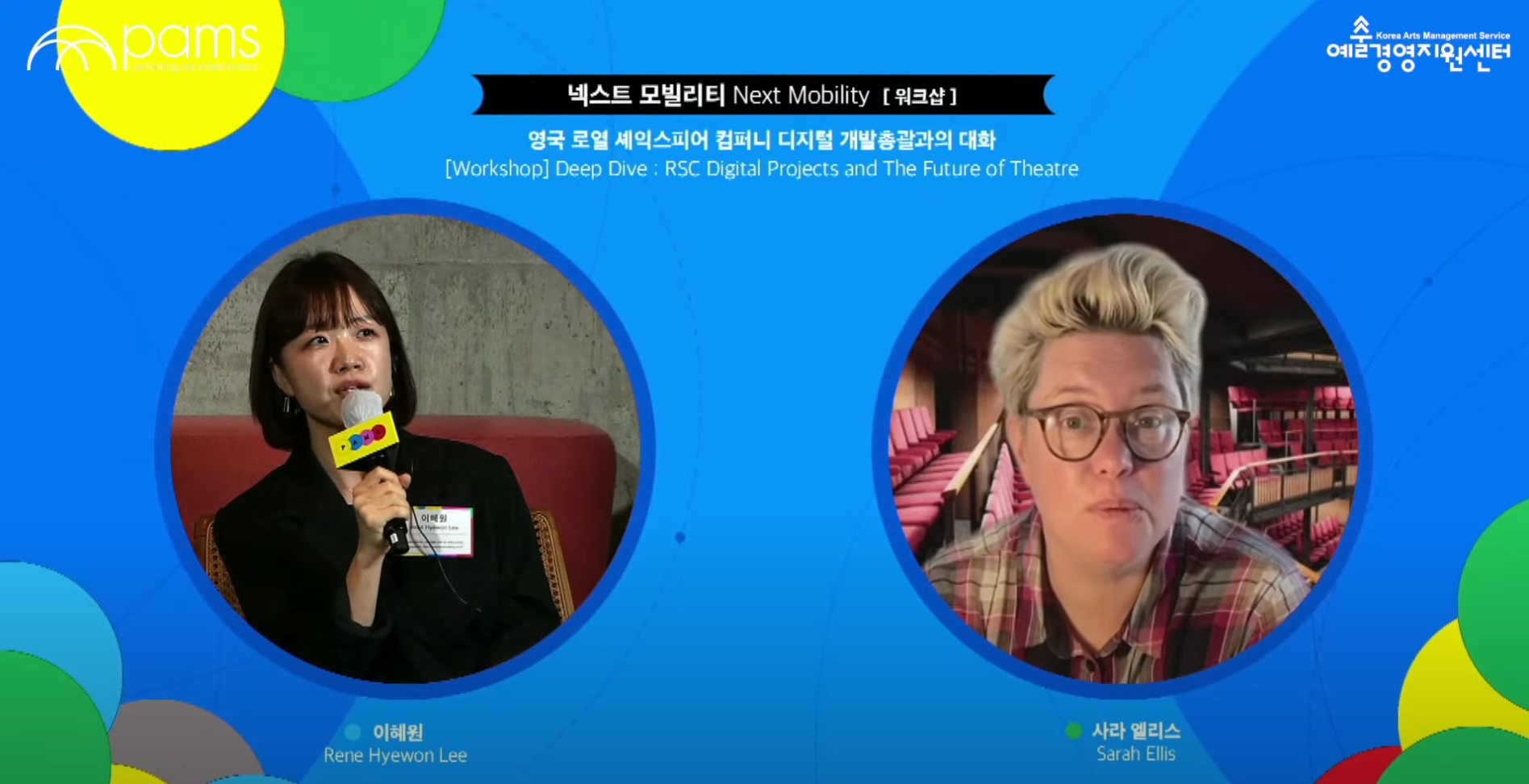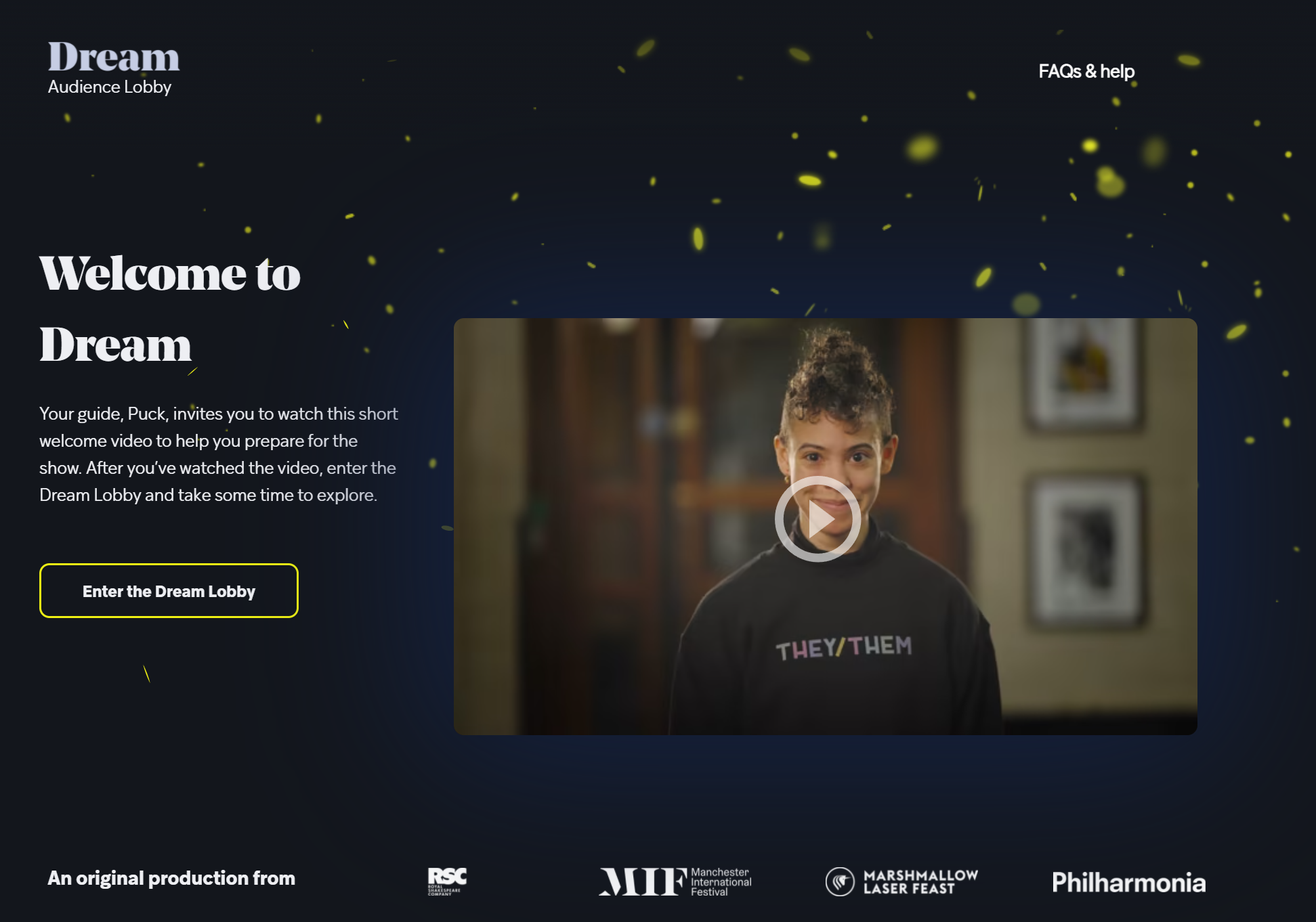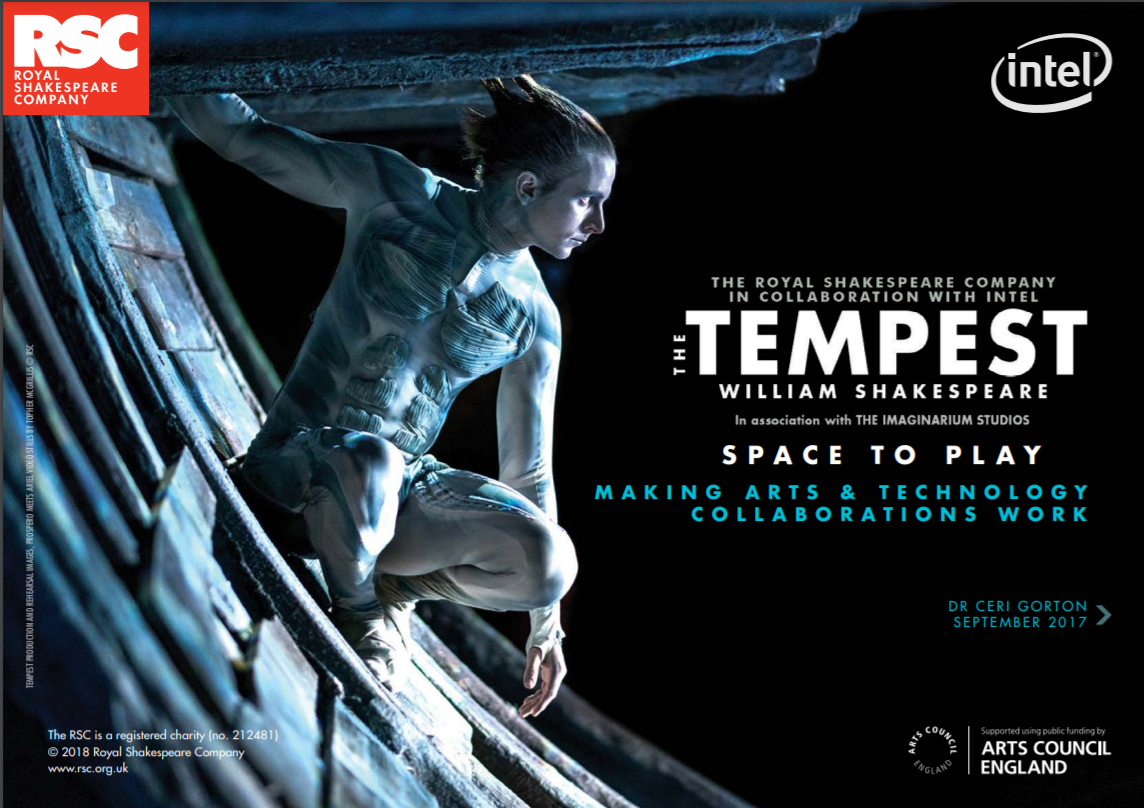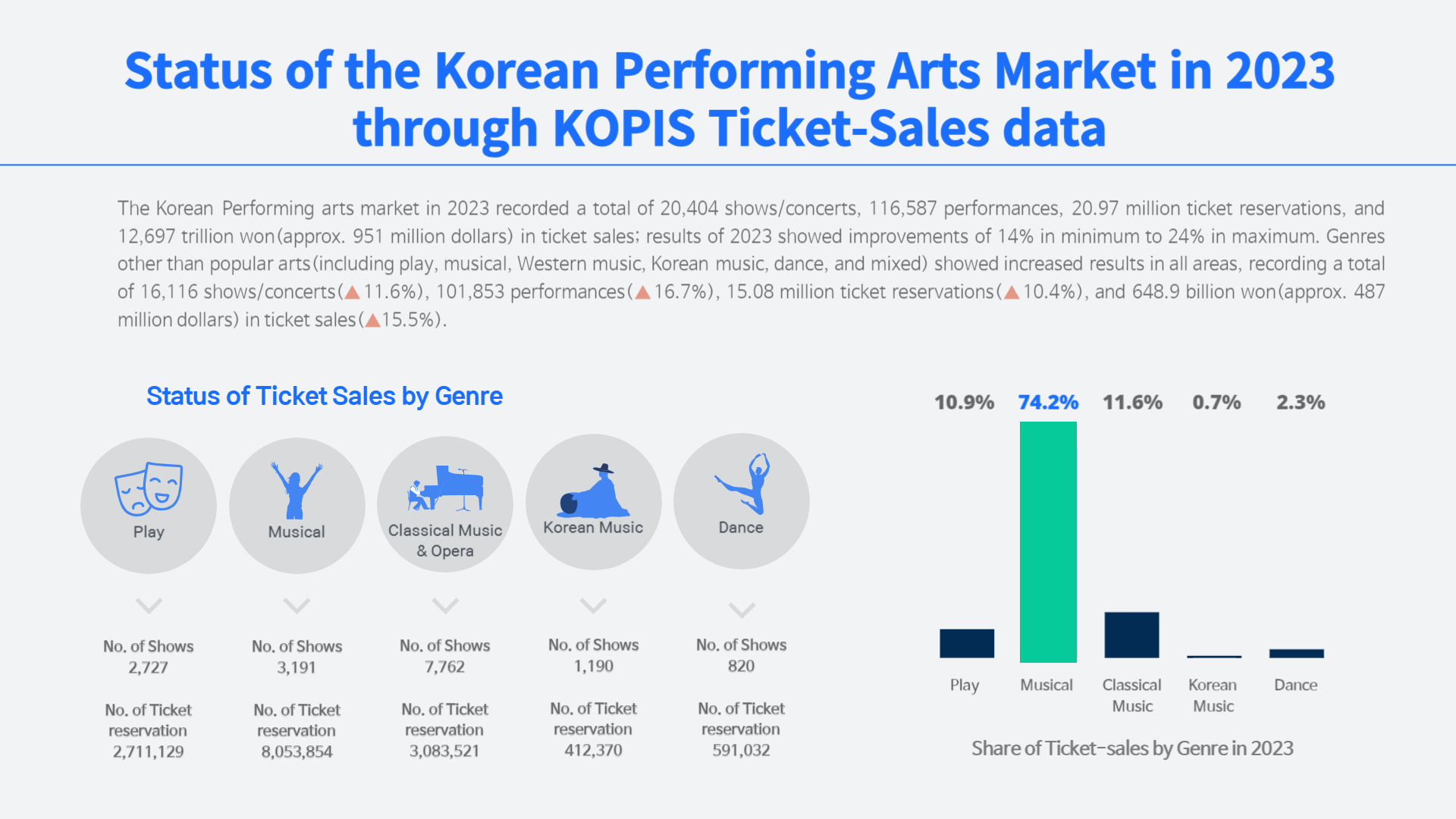New ‘Connection’ among Audience, Performance, Theater and Technology
_with Sara Ellis, Director of Digital Development at Royal Shakespeare Company
Rene Hyewon Lee, Producer/CEO of Giioii Immersive Storytelling Studio

Screenshot of Next Mobility session, courtesy of Performing Arts Market in Seoul
Even the Royal Shakespeare Theatre, one of the most prestigious in the UK with an audience of around one thousand per night, could not avoid the impact of the pandemic. Its impact required a major transition to the use of digital technology which allowed the theater to reopen doors that had remained closed for the last two years. In March 2021, the Royal Shakespeare Company (RSC) carried out the Dream Project. It was an opportunity for the RSC to explore the future of the performing arts by examining future technologies that enable live performances without the limits of physical distance. At the same time, it was a creative experiment involving various technological approaches to how the theater should adapt in the digital world and how the performing arts can adopt interactions enabled by digital technologies. This innovative experiment has yielded encouraging results in attracting an audience of 65,000 from 92 countries for only ten performances, 76% of whom being first time visitors to the RSC and 40% being a young audience.
Digital technology has prompted a new form of mobility. The next mobility sessions of this year’s PAMS have foreseen what changes it will bring, and seek to ask meaningful questions in the era of digital transition. To this end, the sessions were joined by leading groups and artists around the world who have carried out pioneering experiences and experiments. As Head of Digital Development at the RSC, Sarah Ellis has been leading the company’s efforts to bring arts and technology through years of digital experiments. During the Next Mobility session with her, she shared the lessons she learned throughout the pioneering experiments to shed light on important issues and upcoming changes.
She shared two cases in which innovative technologies have ushered in new forms of the performing arts: first, the Dream project which tried to change the value chain of the performing arts throughout creation, circulation and theatre experience, and second, the Tempest which adopted cutting edge technologies such as real-time motion capture technology for physical performances. What kind of leadership is called for in the era of technological changes? What is the future of the theater, and who is the audience? How is digital technology changing the interaction with the audience? These are the most important issues that everyone is facing now that I had discussed with her, and I realized that eventually they all point toward the same conclusion, i.e. ‘connection’. What is indeed the meaningful ‘connection’ in the era of disconnection?
Initiatives for the Audience of the Future: Performance that comes to the audience’s homes
Dream, a reinterpretation of A Midsummer Night’s Dream, was originally planned as an in-person performance to be presented on a physical stage using real-time capture technology. COVID-19 has interrupted the production process, but RSC was looking to make new changes and took this as an opportunity to redefine connection with the audience. This initiative led them to ask questions such as, what does the audience need now that they are away from the theater? Or, what are their expectations? They started from these; coming to the homes of the audience where they live, rather than leaving the door open and waiting for them to come to them; thinking about how to approach the audience’s space and what they must do in order to be welcomed into it; fundamentally transforming the online performance by changing the ideas about the links with the audience.

Screenshot of RSC Dream Website(Source: https://dream.online)
How to connect to the people who cannot come to the venue? Above all, the RSC did not overlook the fact that the audience is a community. The performance is not something to merely watch or attend, but it is a communal and social experience in which all of the members share time and space. The moments, such as when the audience excitedly enters the venue, or when they leave their coats at the cloakroom, receive programs, or share their excitement with friends, are all recreated digitally, and this shows how much thought the RSC has put into designing the digital experience. The digital theater built on their website also visualizes thousands of others accessing it in order to give a sense of belonging. A talk with the audience that usually comes after the performance was moved to the pre-Show event so that it helps the audience understand the technologies. It gave the team a chance for a tech rehearsal as it prepares the audience for a new digital performance experience. This shows the RSC’s effort to realize the links that the theater makes as a cultural and social space connecting people and performances as much as possible.
Other than designing the experience, what else did the RSC have to consider in order to have everyone around the world enjoy their performances and not just the audience from the UK? To make their work innovative creations that embrace the changes of the era, rather than making a video recording and ‘copying’ it to digital media, the RSC considered three things: togetherness, liveness and digital inequality. Technological accessibility is the biggest barrier when making a new technological approach. In terms of experience and proficiency, there is disparity in the audience’s digital literacy and equipment, and in the infrastructure for connection they can access. The more carefully you predict what factors you must consider, the wider the audience you will be able to reach. However, if you want to maintain the quality of the experience at the same level throughout different environments including tablet, mobile phones and desktop, it will increase the scope of development. However, the RSC noted that the future has to have diverse connections at its center and be more inclusive. Therefore, it excluded the HMD which is not as widely used. Instead, the performance was developed to allow the audience access it online using mobile gadgets. As the RSC expanded its target audience to everyone around the world, it presented a performance at 2 a.m. UK time as a bold experiment to adjust the time of performance in consideration of other local time zones. In order to make the environment more inclusive, the audio description, subtitles, and sign language had to be considered, but it was not easy to incorporate everything into the performance. Considerations that need to be made for the digitally isolated communities remain a question for the RSC as it moves on to its next project.
The RSC has collaborated with tech experts in order to reach a bigger audience, and created an R&D consortium with various art companies, festivals and schools including the Manchester International Festival, the Philharmonia Orchestra. As a cooperative body sharing a common vision and goal, the consortium explored what needs to be done for the audience of the future not as a lone project of the RSC but as a community. It also explored how a community made of groups for a large-scale collaboration can move and work organically under a shared vision. To fully serve its purpose as an R&D project, it aimed to share its experiments, challenges and results with everyone working on site in the performing arts sector. Therefore, the surveys done in advance of the performance to find out about audience needs were detailed and lively in their language, and the surveys for feedback were elaborate and thorough with almost 100 questions.
Prerequisites for a technological experiment to become a creative collaboration: the importance of transformational leadership

The Tempest by RSC (Source: https://www.rsc.org.uk/the-tempest/)
In 2016 the RSC’s performance, the Tempest, used the most cutting-edge technologies as an experiment to present a digital character of Ariel at an enormous scale on the stage. The RSC was preparing to present Shakespeare’s last play, The Tempest, to mark the 400th anniversary of his death, and it wanted to encapsulate the magic and imagination of Shakespeare by using technologies. During the technological development it carried out for around two years with tech companies such as Intel, the RSC tried to use experimental technologies that enable an avatar of enormous scale to move around as a part of the performance in real time by using 27 projectors, rather than recording a performance to edit it in post-production. These technologies were unprecedented on the physical stages of the performing arts. They are ahead of their time even in the current digital environment that new technologies such as metaverse have ushered in, where we see digitally created avatar characters perform.
During these technological experiments, the RSC always wanted to go back to its roots. It started from the documents of Shakespeare from 400 years ago. They found out that there was an experiment back then, in which the audience were asked to use jewelry or mirrors to reflect lights on the stage as an effort to find ways to provide a more immersive experience for them. This tells us that technology has always coexisted in the theater. It also emphasizes that, just as the audience goes beyond being individuals to exist as a community, the performance needed an approach in which it seeks a technological partnership to transform itself because performing is not something you do on your own but is a creative collaboration.
Sarah Ellis thinks that the most important principles for collaboration are as follows. Firstly, she emphasized the attitude of respecting technological partners you work with and acknowledging their expertise, saying that “artists have to become engineers, and engineers should learn to become artists.” She doesn’t mean that everyone has to learn coding and technologies themselves, but rather emphasizes respect for each person’s field of expertise and attitude to learning. Secondly, she sees the importance of the cultural change that breaks hierarchy. A digital performance or technological experiment has to provide new time and space. To do so, both artists and engineers have to run tests and wait to see the outcome while working under unconventional conditions and environments. This requires careful consideration, respect and patience. She said that one mustn’t keep demanding results in a coercive manner or criticizing in a cynical tone, and that a change of perspective to ask constructive questions is what’s truly necessary. Thirdly, she emphasized the importance of transformational leadership in order to drive technological cooperation. Open minded leadership is essential in order to; stay on top of the current trend flexibly; adapt to the rapidly changing environment; and add motivation to bring changes. She also underscores the importance of learning from the future generation who are more technologically capable as well as staying alert to remain connected.
History has always shown that art and society keep evolving through innovation and technology. Technology has been developing even before the start of the pandemic, but the traditional performing arts were slow to adopt it. However, even they are compelled to think about digital mobility once again by the new era of the transition we are facing now. The RSC’s digital experiments tried to; develop the audience of the future who spend more time in the digital world; connect performances and actors to the audience; and create a live atmosphere, community experience and presence. They are suggesting that eventually new mobility will lead to more connections.
The discussion I had with Sarah Ellis has brought up a topic that we need to keep exploring, learning, and asking questions on. It reminded us that it is time for us to redefine the audience that it is at a distance. Adding that we need to communicate with the audiences of now who want to see and participate in the digital interaction in their daily lives, in order to find out what they want from the digital stage and performing arts scene. It also made us realize that we need to accept and communicate with technological experts under a shared vision and goal to see if technology can evolve the performing art scene while continuing small and meaningful experiments. Sarah Ellis started her discussion with David Bowie’s quote, “tomorrow belongs to those who see it coming.” I want to conclude this article with that quote, hoping to see creators, audiences and technological experts coexist and explore the future in solidarity, and to see the new mobility continue to be innovative while moving forward with the community.
Producer/CEO of Giioii Immersive Storytelling Studio
Rene is a producer and CEO of Giioii Immersive Storytelling Studio. Giioii is a transliteration of the Korean acronym for “Stories that blend well with technology.’’ She is also a lecturer at the Korea National University of Arts. She has been gaining experience in areas where culture and art combine with technology including multidisciplinary art performance, art and technology, content industry and VR startups in the US. She runs a magazine about XR based realistic content, ixi.media. She produces original XR content, and exhibitions connecting virtual reality and reality, metaverse and virtual cultural experiences. She works as a producer who mediates art and technology, and connects stories.
rene.lee@giioii.com/ @giioii_immersivestudio








 PREV
PREV

.jpg)
.jpg)
.jpg)
.jpg)











